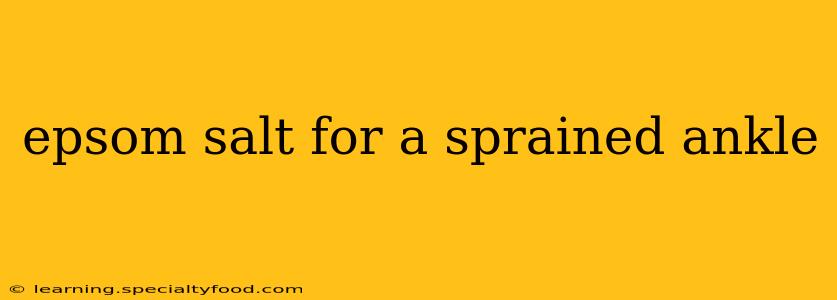A sprained ankle, characterized by stretched or torn ligaments, is a common injury causing pain, swelling, and limited mobility. While medical attention is crucial for severe sprains, Epsom salt soaks offer a time-tested, at-home remedy to ease symptoms and promote healing. This article explores the benefits, methods, and precautions associated with using Epsom salt for a sprained ankle.
How Does Epsom Salt Help a Sprained Ankle?
Epsom salt, chemically known as magnesium sulfate, is a naturally occurring compound. When dissolved in water, it breaks down into magnesium and sulfate ions, which are absorbed through the skin. These ions are believed to offer several benefits for sprained ankles:
- Reduces Inflammation: Magnesium possesses anti-inflammatory properties, helping to decrease swelling and pain associated with the injury.
- Eases Muscle Pain: Magnesium also plays a crucial role in muscle function and relaxation. Soaking in Epsom salt can alleviate muscle spasms and reduce discomfort.
- Promotes Healing: Sulfate helps to flush out toxins and reduce inflammation, potentially speeding up the healing process.
How to Use Epsom Salt for a Sprained Ankle?
Creating an Epsom salt soak is simple:
- Water Temperature: Fill a tub or large basin with warm (not hot) water. Hot water can worsen inflammation.
- Epsom Salt Quantity: Add approximately 2 cups of Epsom salt to the water. Stir until it dissolves completely.
- Soak Time: Immerse your sprained ankle in the solution for 15-20 minutes. You can repeat this process several times a day, as needed.
- Aftercare: Gently pat your ankle dry after the soak. Avoid rubbing, as this can irritate the injured area. Consider elevating your ankle above your heart to further reduce swelling.
What are the Precautions when Using Epsom Salt for a Sprained Ankle?
While generally safe, there are some precautions to consider:
- Open Wounds: Avoid using Epsom salt if you have open wounds or broken skin on your ankle. The salt can sting and delay healing.
- Allergies: Some individuals may be allergic to Epsom salt. If you experience any skin irritation, discontinue use immediately.
- Underlying Medical Conditions: Consult your doctor before using Epsom salt if you have any underlying health conditions, such as kidney disease or heart problems. Epsom salts can have certain interactions with medications.
- Not a Replacement for Medical Care: Epsom salt soaks are a complementary therapy, not a replacement for professional medical care. Always seek medical attention for severe sprains or if symptoms worsen.
Does Epsom Salt Reduce Swelling in a Sprained Ankle?
Yes, Epsom salt's magnesium content contributes to its anti-inflammatory properties, helping to reduce swelling in a sprained ankle. The sulfate may also assist in flushing out toxins that can contribute to inflammation. However, it's crucial to remember that elevation and rest are also essential for reducing swelling.
How Long Should You Soak Your Ankle in Epsom Salt?
Soaking your ankle in an Epsom salt solution for 15-20 minutes is generally recommended. Longer soaks may not offer additional benefits and could potentially dry out your skin. You can repeat the soak several times a day, depending on your comfort level and the severity of your sprain.
Can Epsom Salt Soaks Help Speed Up Ankle Sprain Recovery?
While Epsom salt soaks can alleviate pain, reduce inflammation, and promote relaxation, they don't directly speed up the healing process of ligament damage. The recovery time depends on the severity of the sprain and proper medical care, including rest, elevation, compression, and potentially physical therapy. Epsom salt soaks offer supportive relief but shouldn't be considered a primary treatment method.
Are There Any Side Effects of Using Epsom Salt for a Sprained Ankle?
Side effects are generally rare but can include skin irritation or dryness. If you experience any allergic reaction or discomfort, stop using Epsom salt and consult a doctor. Always use lukewarm water, as excessively hot water can aggravate the injury. Overuse can also dehydrate you.
When Should You See a Doctor for a Sprained Ankle?
You should seek medical attention if your ankle sprain is severe, accompanied by intense pain, significant swelling, inability to bear weight, or persistent numbness or tingling. A doctor can properly diagnose the sprain, rule out fractures, and recommend appropriate treatment plans, which may include physical therapy, bracing, or other interventions.
By following these guidelines and combining Epsom salt soaks with other recommended treatments, you can effectively manage the pain and inflammation associated with a sprained ankle and support the healing process. Remember to always consult a healthcare professional for diagnosis and treatment of any injury.
